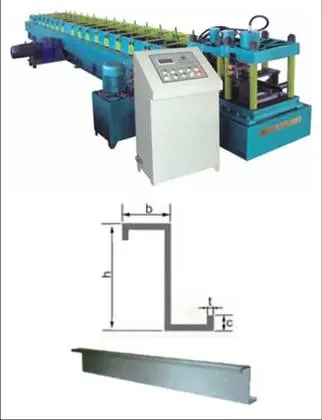
Understanding the PLC-Adjusted Size C and Z Purlin Machine
In the realm of modern manufacturing, the precision and efficiency of processes have become paramount. One of the significant advancements in steel building components is the PLC-adjusted size C and Z purlin machine. This innovative machinery plays a crucial role in the construction industry, allowing for rapid production of purlins that are essential for structural framing. But what exactly does this entail, and how does PLC adjustment enhance the manufacturing process?
What are Purlins?
Purlins are horizontal supports for roofs and walls in a building's framework. They serve a critical function in distributing loads and providing structural integrity. Purlins can typically be found in two shapes C and Z. The choice between C and Z purlins often depends on design requirements and specific structural functions.
- C Purlins The C shape is often used for lighter loads and serves as the primary beam for supporting roof structures. - Z Purlins Z purlins are more robust and can allow for longer spans when used; they also can save considerable material when overlapping, enhancing the overall structural efficiency.
The Role of PLC in Purlin Machines
PLC, or Programmable Logic Controller, is a crucial component in modern manufacturing automation. It is essentially a digital computer used for automation of electromechanical processes, allowing for precise control of machinery operations. The PLC-adjusted size C and Z purlin machine uses this technology to optimize production processes in several significant ways
1. Precision Control The PLC system ensures that every cut and bend of the purlins is done with high accuracy. This reduces material waste, saves time, and enhances product quality.
2. Versatility in Sizing One of the standout features of PLC systems is their ability to adjust purlin sizes quickly. Operators can input desired dimensions into the system, which seamlessly changes the machine settings to accommodate different sizes without needing extensive manual adjustments.

3. Reduced Production Time Traditional methods often require significant downtime when changing specifications. With PLC systems, the transition between different purlin sizes is nearly instantaneous. This efficiency can drastically reduce production time, allowing manufacturers to meet tight deadlines.
4. Remote Monitoring and Debugging PLCs support remote access, enabling operators to monitor machine performance and troubleshoot issues without being physically present. This feature enhances productivity and reduces the likelihood of costly machine downtime.
5. Data Collection and Analysis PLCs can collect data during the manufacturing process, providing insights into production trends and machine performance. This data can be invaluable for continuous improvement efforts, helping manufacturers optimize operations further.
Applications of PLC-Adjusted Purlin Machines
The application of PLC-adjusted size C and Z purlin machines is broad and includes various industries
- Commercial Construction Used extensively in warehouses, retail spaces, and other commercial structures. - Industrial Buildings Ideal for factories and production facilities where quick assembly and structural soundness are vital. - Agricultural Structures Often employed in the construction of barns, silos, and other agricultural buildings, where weight and load distribution are crucial.
Conclusion
In summary, the PLC-adjusted size C and Z purlin machine represents a significant leap forward for the construction and manufacturing industries. By harnessing the power of automation and precision engineering, these machines provide numerous advantages, from reducing waste to increasing production speed and ensuring robust structural components. As industries continue to evolve, the integration of advanced technology like PLC in purlin machines will undoubtedly remain at the forefront, driving efficiency and innovation in building infrastructure. Through the effective use of these machines, manufacturers can meet the demands of a growing market, ensuring quality structures are built to last.